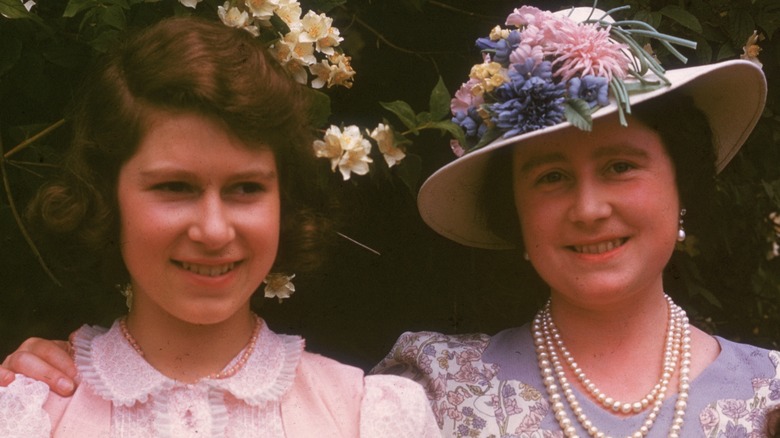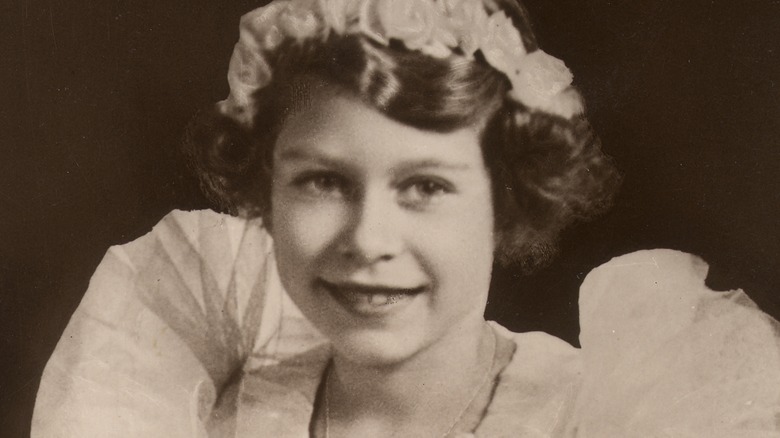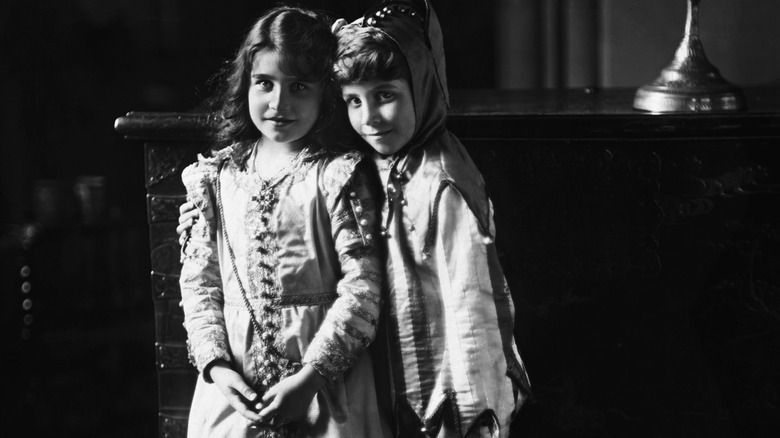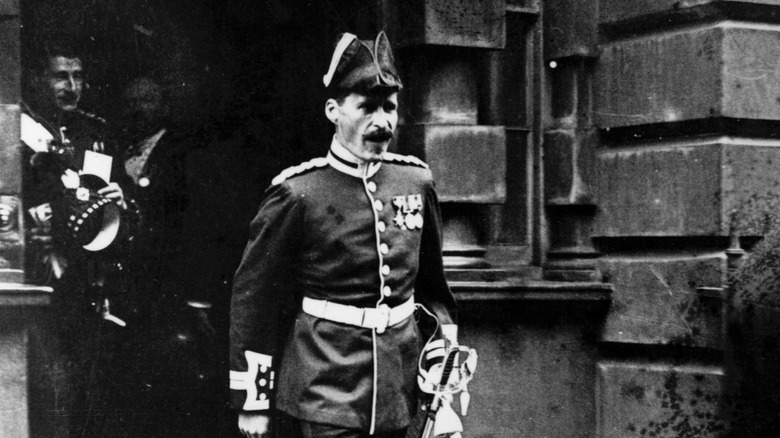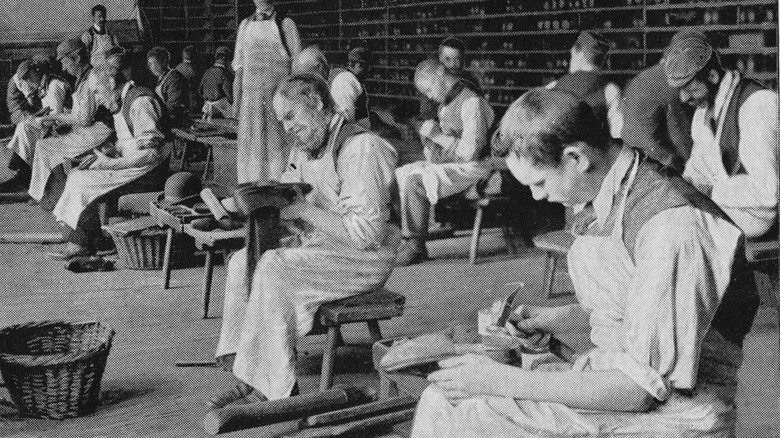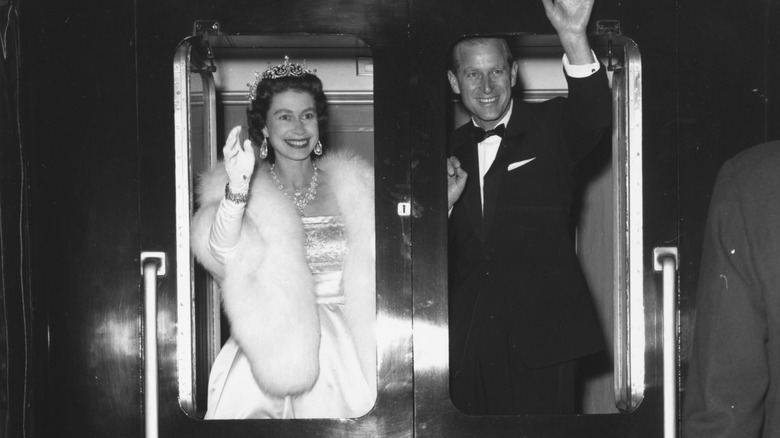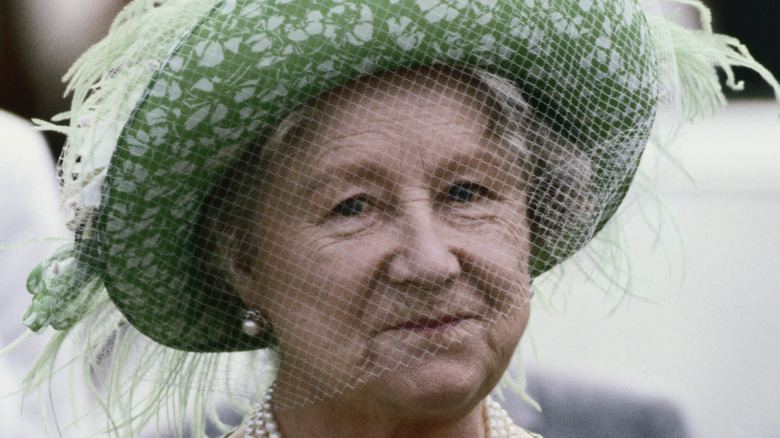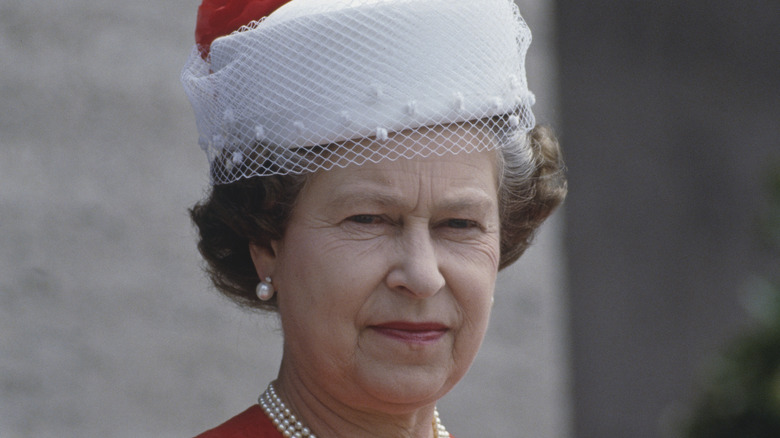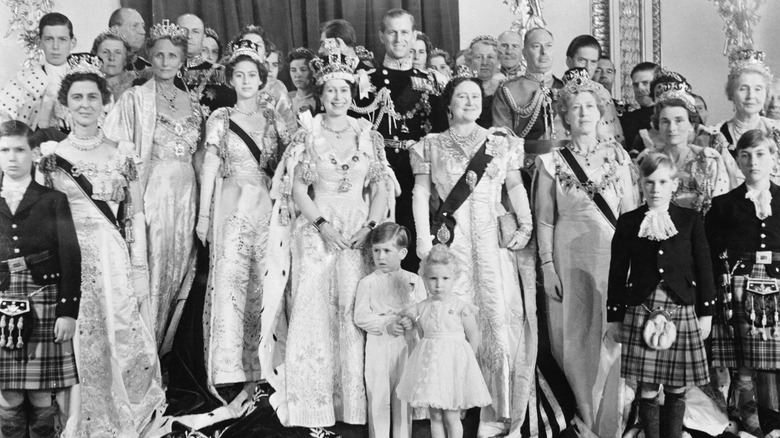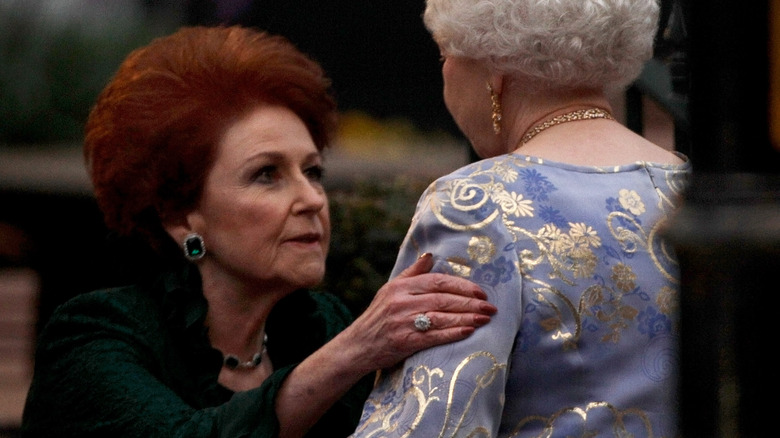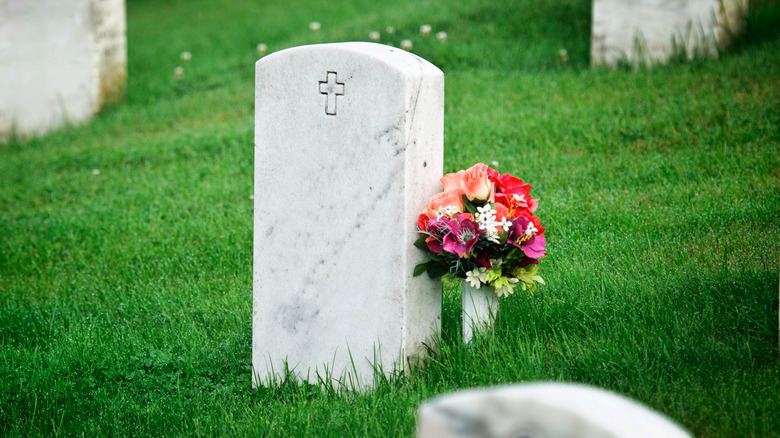The Tragic Story Of Queen Elizabeth's Hidden Cousins
We all know the main members of the British royal family, from Princess Catherine to Camilla, the queen consort. They are faces we see time and time again, representing the great monarchy that Queen Elizabeth II oversaw for decades. However, the House of Windsor is a complex dynasty that spans generations, weaving a far more intricate family tree than most of us realize.
Like every family unit, the Windsors have their secrets — including the sad tale of Elizabeth's first cousins, Nerissa and Katherine Bowes-Lyon. There have been many royal scandals over the years that have threatened the integrity of the sovereign, but this particular event challenged the public perception of the British royal family in a different way.
The curious tale of the Bowes-Lyon sisters both intrigued and appalled the public, bringing with it a media storm that no one saw coming, not least of all the queen. Even now, over 30 years after the story broke, the world continues to be fascinated by the entire situation. How did the two girls simply fade from view considering they were closely related to the most famous monarch in the world? Why were they registered as deceased when they were alive and well, and what other skeletons lurk in the closet of the infamous House of Windsor? From alleged payoffs to secret funerals, this is a desperately tragic tale that won't be erased from the history books in a hurry.
Katherine and Nerissa Bowes-Lyon were closely connected to Queen Elizabeth II
Even for the most astute historians, trying to trace the royal family lineage can be a confusing task that leaves them scratching their heads. With that being said, it may be easy to assume that Nerissa and Katherine Bowes-Lyon were distant relatives of the queen and not in her immediate family circle. That isn't the case.
The two girls were the daughters of Queen Elizabeth II's maternal uncle, John Herbert Bowes-Lyon, and his wife, Fenella Bowes-Lyon. The couple had five daughters, welcoming Nerissa in 1919 and Katherine in 1926. Tragically, their firstborn died as an infant. While the bloodline is certainly close, there is little information on whether the Bowes-Lyons spent a lot of time with Elizabeth's side of the family.
Like many monarchs before her, Elizabeth never publicly spoke about the family dynamic, including who she spent time with growing up. Photos of the Bowes-Lyon sisters as children do exist, but they are few and far between, and the siblings do not appear in any publicly released group photos from the time. Considering Elizabeth's mother was their paternal aunt and Elizabeth only became future queen when King Edward VIII abdicated the throne in 1936, it's not a stretch to assume that Elizabeth socialized with her cousins at family gatherings on at least one occasion. However, things may have changed when Elizabeth became heir.
They were born with learning difficulties
Katherine and Nerissa Bowes-Lyon were physically healthy children, but both were born with developmental disabilities that impacted their ability to navigate the world. Sadly, at the time they lived in a society that deemed their uniqueness as taboo, especially for a dynasty of high social standing. Instead of being supported and accepted as they would be today, they were seen as scandalous. In the early 20th century, there was limited medical knowledge of disabilities, meaning the Bowes-Lyon sisters would have been largely misunderstood. Thankfully, times have changed since then.
At the time there was no set diagnosis, but it was later revealed that the girls had a genetic condition. What's more, they weren't the only members of the queen mother's family to have been born with it. (The queen mother is pictured here with the girls' father, John Bowes-Lyon.) Three other female cousins and siblings, Edonia, Rosemary, and Etheldreda Fane also had the same disability, making this a more widespread family occurrence than first thought.
Not much is known about the three sisters, but it was reported that Nerissa and Katherine Bowes-Lyon had a mental age of about 6 years old. They couldn't do many things for themselves, never developed the ability to speak, and would have required a great deal of supervision and care. Despite this, they were raised at home alongside their siblings until their world was turned upside down in 1941. After that, nothing was ever the same.
They were sent away to an institution after the death of their father
The girls' mother, Fenella Bowes-Lyon, continued to care for her daughters at home, even after the death of her husband, John Bowes-Lyon, in 1930. He was a relatively young man at the time, falling victim to pneumonia in his early 40s and leaving behind his children and wife.
However, over a decade later, Katherine and Nerissa Bowes-Lyon were sent away from their Scottish home, Glamis Castle, to live at Royal Earlswood Hospital at Redhill, Surrey. To this day, an explanation for the change has never been provided, with Nerissa 15 years old at the time and Katherine age 22. By this age, both girls would have been very accustomed to life at home with their mother and siblings. This marked the beginning of a lifetime of institutionalization for them, as they would never come home again.
Their surviving two sisters went on to lead full lives, with one of them marrying Prince George Valdemar of Denmark in 1950 and becoming Princess Anne of Denmark. All the while, the Bowes-Lyon girls lived out every major event as patients at the hospital, from birthdays to Christmas. Their life was in stark contrast to that of the rest of their family, some of whom became royalty, some who became mothers, and all who had their freedom at their disposal — something many of us take for granted at the best of times, whether we realize it or not.
What was life like at the institution?
You may think it was an upscale facility, considering the type of family Katherine and Nerissa Bowes-Lyon came from, but it was the opposite. Although Earlswood Hospital consisted of an imposing building that looked like a sprawling mansion, what lay behind its doors was vastly different. Built in 1852 by William Bonython Moffat, the hospital was designed to house patients with disabilities, and according to Historic England, was the first in Britain to do so. When it was opened, it was called the "Earlswood Asylum for Idiots," which gives us insight into just how different times were back then.
Unfortunately, the hospital struggled with the pressure. In a Channel 4 documentary based on the Bowes-Lyon sisters called "The Queen's Hidden Cousins," former employees and relatives of patients described severe staffing issues and wards holding 40 patients at a time. The documentary also claimed that the sisters didn't receive visitors, birthday presents, or cards. Essentially, they were forgotten (via inews).
However, a former employee of the East Surrey Health Authority told a different story when the news originally broke in 1987, telling The Associated Press, "Both sisters had regular visits from their families up until the early 1960s when one of their closest relatives died ... Since then, they have had few visitors" (via Tatler).
They were both reported dead
As if their situation weren't tragic enough, Katherine and Nerissa Bowes-Lyon's story only became more saddening as the years ticked by. For decades, the sisters still weren't public knowledge, not least because they were reported dead in a trusted society report called "Burke's Peerage" in 1963. When it was published that Nerissa had died in 1940 and Katherine in 1961, nobody questioned it. As a result, the Bowes-Lyon sisters faded further and further from view.
Only those closest to the two sisters knew the truth — that they weren't dead at all. Even though they were dead to the world, as far as the Bowes-Lyon girls were concerned, and as far as the staff that looked after them were concerned, it was life as normal at the hospital. The statement in the publication caused no shock waves as very few were involved with the women at the time anyway, if reports are to be believed.
So how did the reality eventually come to light? The truth did prevail, but it didn't give any definitive answers to this curious twist of events.
In 1987, the truth was revealed
Amazingly, for the next two decades, no one questioned the information in "Burke's Peerage." It was the British tabloid The Sun that revealed the existence of Queen Elizabeth II's secret cousins, shocking the world with the headline, "Queen's Cousin Locked in Madhouse" (via Los Angeles Times). The publication also shared a picture of Katherine staring off into the distance. This sparked a debate about mental illness and also caused reporters to dive deeper into royal history, uncovering the information about the other cousins with the same disability. For a family as notoriously private as the Windsors, this would have likely been incredibly unsettling.
Several other newspapers also ran their own commentary on the case, causing a lot of speculation from the public. It was especially stirring as Queen Elizabeth, the queen mother, was a much-loved figure in Britain, with The Independent giving her the title "the best-loved royal" after her death in 2002.
The queen mother, who was a patron of the Royal Society for Mentally Handicapped Children and Adults, supposedly had no idea her nieces were still alive until five years before it became public knowledge. When she found out, she reportedly sent the Bowes-Lyon sisters money to ensure they were well taken care of ... but she didn't reach out to Burke's Peerage to correct the mistake, which some found questionable.
Did Queen Elizabeth II know about them?
Queen Elizabeth II was born in 1926, so she wasn't dissimilar in age to her cousins. With that being said, she would've been just a young teenager when they were sent away, and matters like that probably wouldn't have been discussed in front of her. Reports suggest that Elizabeth, just like the rest of the world, was totally blindsided by The Sun's headline and had no idea Katherine and Nerissa Bowes-Lyon were still alive. She, like other members of the aristocracy, believed they had died in 1940 and 1961 as recorded. If it was a secret even to family members, it begs the question: why?
As previously mentioned, life was very different back then, and having family members with learning disabilities was often frowned upon. Many believe that the cousins were hidden away to protect Elizabeth's reign and to avoid bringing any scandal to the House of Windsor.
While this has never been publicly confirmed, Netflix's semi-fictional series "The Crown" also took this route as an explanation, retelling the story in the Season 4 episode "The Hereditary Principle." When the report came to light in 1987, the palace tried to distance itself from the matter as much as possible, telling The Associated Press, "It is a matter for the Bowes-Lyon family" (via Tatler). The queen never spoke about her cousins in public and kept her distance from the entire affair for the rest of her life.
The sisters still remembered they were part of the royal family
As the outside world learned of their existence, life remained unchanged for the sisters in the institution. Although it's reported that they had the mental age of children, former staff members told Channel 4's documentary crew that they never seemed to forget their royal connections.
Despite the many decades that passed, they continued to recognize when the royals appeared on TV, even standing up and saluting or giving a curtsy as a sign of respect (per Digital Spy). It just goes to show that even though they were kept away from their family, Katherine and Nerissa Bowes-Lyon couldn't shake their heritage. Their aristocratic upbringing was ingrained in them to the core. As the siblings were very closely related to the monarchy, they would have been taught how to display the proper etiquette around members of the royal family from a very early age.
Although the Bowes-Lyon girls were institutionalized from the relatively young ages of 15 and 22, they spent their childhood growing up at home in Scotland under the guidance of their two sisters and mother. They remained nonverbal their entire lives, but the sisters were still able to communicate.
The family denied any cover-up took place
Staying silent may have been Buckingham Palace's attempt to deflect attention away from the situation, but it only served to create more questions. The public simply couldn't understand why the Bowes-Lyon sisters were kept such a secret, which created rumors that a cover-up had taken place. Even though Queen Elizabeth II allegedly didn't know they were still alive, and the queen mother only found out five years prior, The Telegraph reported that someone in the palace had been sending the hospital money to care for the sisters: "The Bowes-Lyon sisters seem to have been entirely abandoned by the royal family, aside from the £125 a year they paid Earlswood." Exactly who arranged for the funds to be sent remains unknown.
As for the rest of the Bowes-Lyon family, they firmly denied that there was any attempt at falsifying information or hiding them. Lady Elizabeth Anson, daughter of Princess Anne of Denmark, released a statement in 1987 explaining that her grandmother Fenella Bowes-Lyon was "a very vague person [who] often did not fill out forms completely that 'Burke's Peerage' sent her" (per The Associated Press).
According to her, it was simply a matter of crossed wires and not an attempt to keep the sisters hidden from public view, despite what the media and the public felt.
A tragic end to a tragic tale
Although initial reports of their deaths were false, by the time the existence of Katherine and Nerissa Bowes-Lyon became public knowledge, Nerissa really had died. The eldest of the two sisters died in 1986, just a year before The Sun report, leaving Katherine on her own in the hospital. The public was shocked to discover Nerissa had been buried in a grave without a stone, with just a plastic marker labeled with her surname to identify it. Not only that, but no one from the royal family was in attendance at the funeral, just staff that had cared for her during her many years in the institution. A real gravestone was added a year later.
Many people across the country were so moved by the story that they sent the remaining Bowes-Lyon sister flowers as a gesture of comfort. As for Katherine Bowes-Lyon, her story didn't come to an end until 2014 when she died aged 87. After spending most of her life at Earlswood Hospital, she was moved to a care home when it closed in 1997, remaining there until her death.
Both sisters were buried at Redstone Cemetery, near the hospital where they spent their lives. Several decades on from when the scandal erupted, the story of the queen's hidden cousins poses many questions whose answers will remain lost in time — but one thing is for certain, Katherine and Nerissa Bowes-Lyon will never be forgotten again.
